How London Became One of the World’s Most Diverse Dining Destinations

Julie Bang/Travel+Leisure
London’s modern status as a global culinary capital is unassailable. Yet just a generation ago, such standing was better described as unthinkable. For what seemed like centuries, in fact, the crown capital was derided as a bastion of blandness. What changed?
Most notably, the city started celebrating and showcasing its diversity like never before. This is, after all, one of the most dynamic melting pots on the planet; more than 300 languages are spoken within its boundaries. Today, they’re speaking out, reshaping the landscape with an enviable array of cultural richness. What a tasty shakeup it’s been.
“I remember moving to London in 2000 and seeing mostly chains like Pizza Express and Aberdeen Angus Steakhouse all over,” recalls Sarah Belizaire, a native Englander and founder of a food and drink consulting firm. “But it all changed so fast. Now, you see almost every country represented from a culinary perspective.”
In lieu of purchasing international airfare, you can take your tastebuds for a ride with nothing more than a ticket on the tube. As Ashley Abodeely points out, London is a city that breaks down its various culinary personalities along neighborhood lines. “I live south of the [Thames] river in Brixton and the cuisine is mainly influenced by Caribbean flavors — primarily Jamaican — as well as Portuguese food,” explains the executive chef for the NoMad London. “While in East London, you will typically find more halal and Turkish foods, along with a strong Indian presence.”
That Indian presence — along with Pakistani — has been thriving here for ages in quaint, family-run establishments like Tayyabs in Whitechapel. “For a great lamb chop, there's nowhere quite like it,” says Rebecca Jago, lifelong Londoner and co-founder of luxury spirits brand The Last Drop. As someone with her own line of liquids, she’s particularly fond of the Punjabi restaurant’s long-standing BYO policy. “For me, my favorite food and drink is always about the people I'm with and the memories we share. And the past few decades have seen a revolution in the variety of food available and in the way we consume it.”
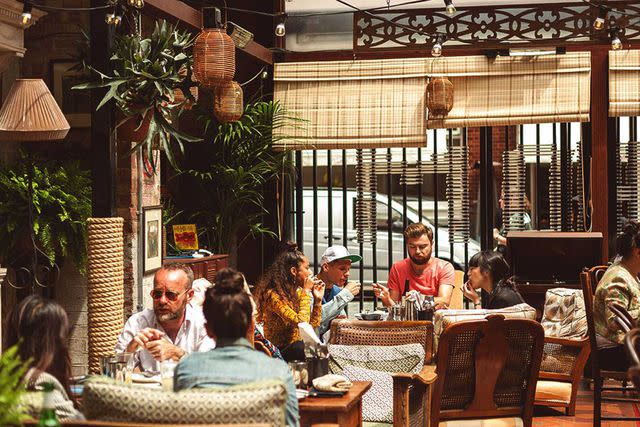
To wit, even the tried-and-true Indian formula has been tinkered with, resulting in the proliferation of places like Dishoom and Brigadiers. These polished eateries pay tribute to mid-20th-century Bombay, but leave room for elements of contemporary fusion and craft mixology. The sustained crowds of their dining rooms suggest the template is a winning one.
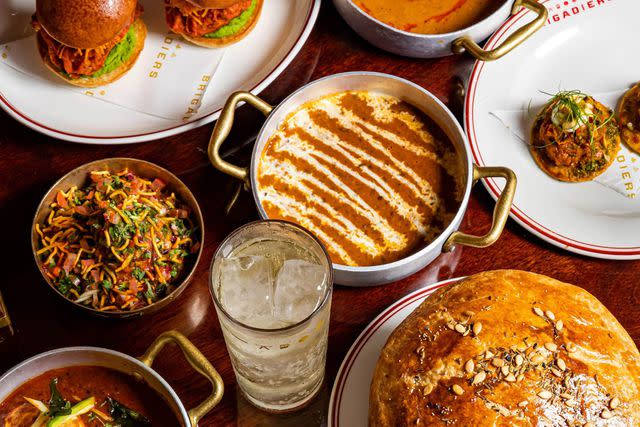
Courtesy of Brigadiers
Nevertheless, some are wary of oversimplification when it comes to certain culinary imports. “The diversity in Indonesian cuisine is mind-blowing,” says Rahel Stephanie, founder of Spoons, a popular Indonesian supper club. “But from that vast variety, the U.K. generally has flocked to just three dishes: nasi goreng, gado-gado, and satay. And more often than not, I’ve found unfortunate misrepresentations of them — including misdefining satay as a peanut sauce. We have 252 skewer varieties, many of which have nothing to do with peanuts.”
To avoid scenarios such as these, Stephanie recommends some cursory research to determine if the restaurant is truly reflective of the region it represents. It’s nothing that can’t be gleaned from even a simple scan of the menu. “Among the disappointing instances, you'll find small, independent Indonesian food business founders and cooks plowing through, serving up authentic dishes humbly and unpretentiously,” she notes, citing notable examples such as Pino's Warung and Triple Hot Spicy. “[They] are especially popular among Indonesians living in London, doing our home country proud.”
The city’s thriving outdoor market scene is another forum fostering authenticity. “Whenever I have friends visiting, I always take them to London Borough Market,” says Mo Elkhiyari, a local professional in the drinks industry. “There are so many flavors to be found, but you need to bring a big appetite because here it’s a marathon, not a sprint.”
Traders in this historic space, just south of the river, range from the handheld Taiwanese specialities of Bao Borough to sustainable Cypriot street food at Gourmet Goat. Elkhiyari is especially fond of Berenjak — a Persian standout paying homage to the family recipes of its founder, Kian Samyani.
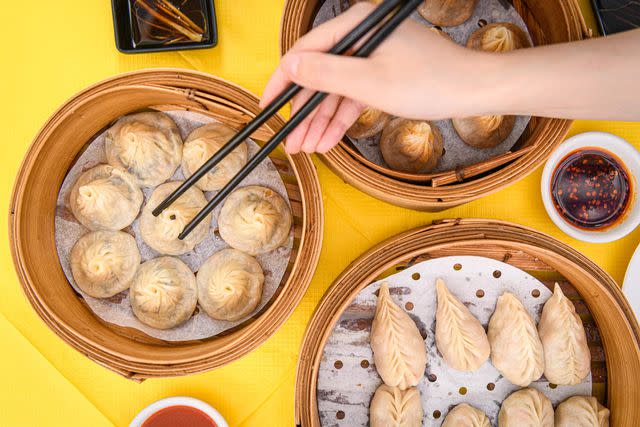
Nic Crilly Hargrave
Ultimately, the appeal of the London scene isn’t just about the range of available cuisines, but also the breadth of price points existing within each. For less than 10 quid, you can gorge yourself on xiao long bao at Dumplings’ Legend in Chinatown. Or, you can walk down the street and savor more buttoned-up dim sum at Yauatcha, where inventive offerings include venison puffs and crispy wild mushroom cheung fun. You can appreciate affordable — and fantastic — Middle Eastern anywhere east of Tower Bridge. Or, make your way to Jeru in Mayfair, where Israeli chef Roy Ner plates halloumi donuts with truffle honey and dry-aged grilled lamb filet with wild garlic awarma.
Jago adds another modern Middle Eastern standout to the list: “One of my favorite restaurants — when I can get a table — is The Palomar on Rupert Street. The bread there is as close to heaven as I've been.”
Even the most ever present of pedestrian fare — pub grub — has been elevated. Remember, this is where the term “gastropub” was coined about 30 years ago, when chef David Eyre and Mike Belben reinvented The Eagle Farringdon in Clerkenwell. It’s still thriving today, along with the movement it inspired.
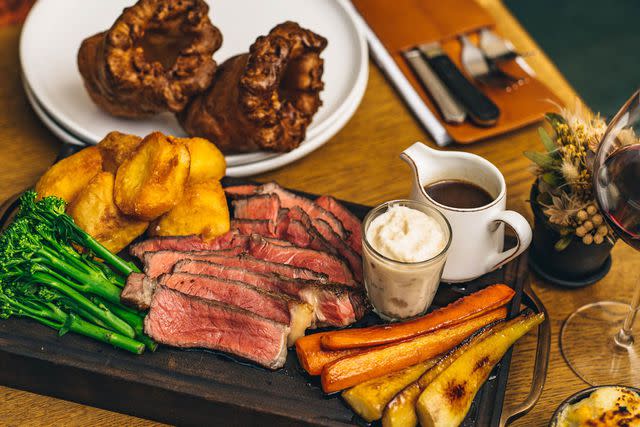
Lateef Okunnu
Stroll into The Harwood Arms on a Sunday (provided you have reservations, of course), and you’ll be treated to a roast to remember. Amble through the elegant interior of The Stafford hotel on any afternoon, and you’ll arrive at the legendary American Bar, greeted by revamped fare from Michelin-starred chef Lisa Goodwin-Allen. That means your fancy martini and craft cask ale will be accompanied by lobster clubs and upmarket fish and chips — beer-battered haddock with triple-cooked chips and marrowfat peas.
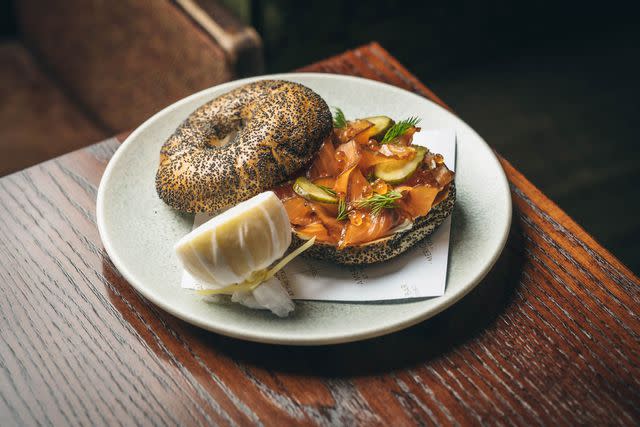
Courtesy of The Stafford London
“However, I think the point about London is not whether or not some place makes a ‘World's Top 50’ restaurants list, but whether or not it gives you pleasure, warmth, and that wonderful sense of familiarity every time you visit,” says Jago. “With such a wonderfully multicultural city, the world really is your oyster. Speaking of which, oysters sitting in the sunshine at Bibendum is another magical moment.”
For more Travel & Leisure news, make sure to sign up for our newsletter!
Read the original article on Travel & Leisure.

